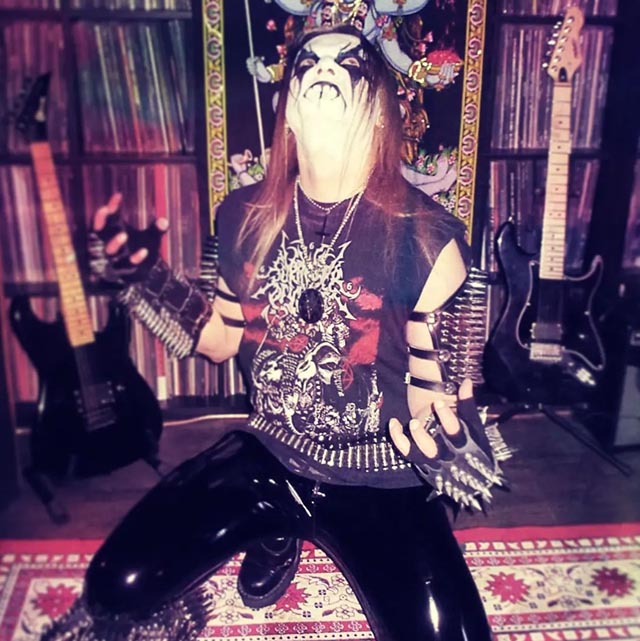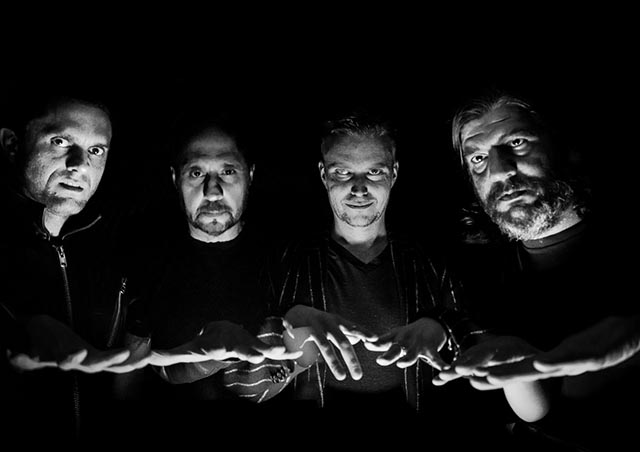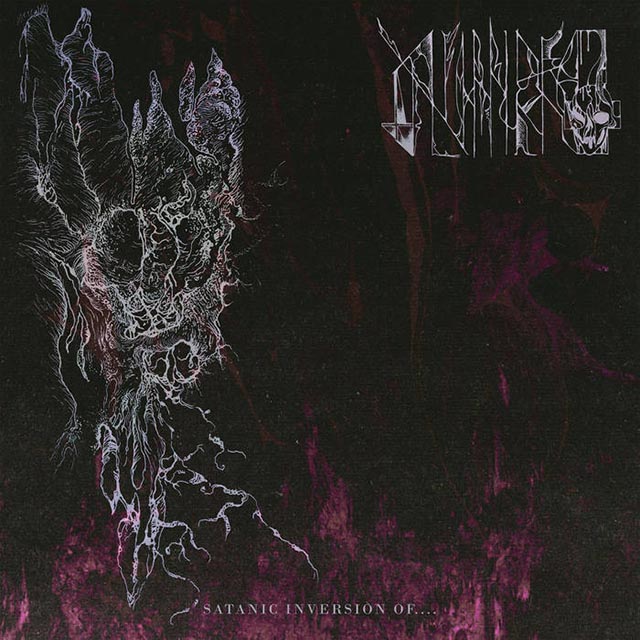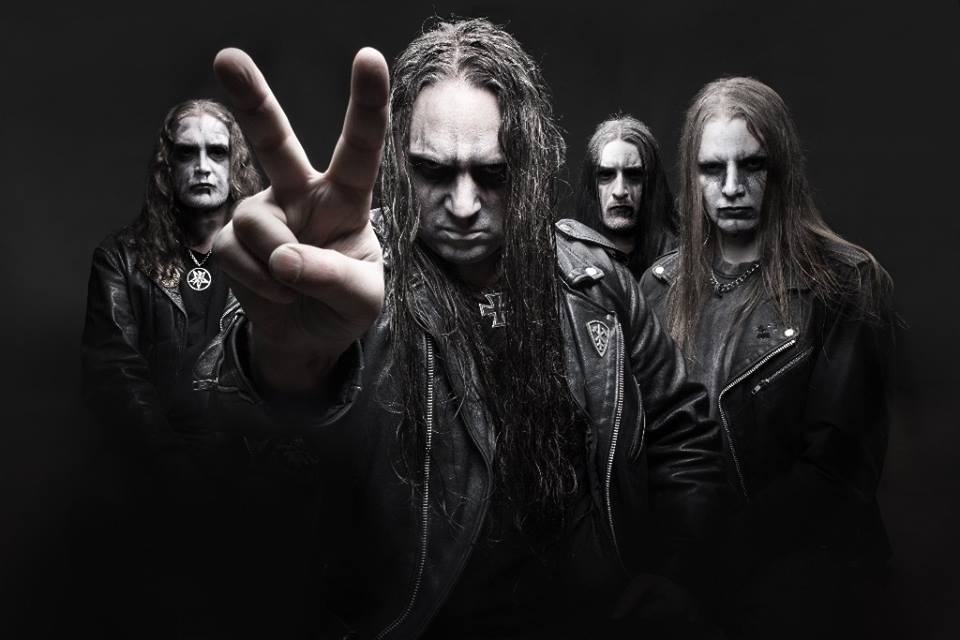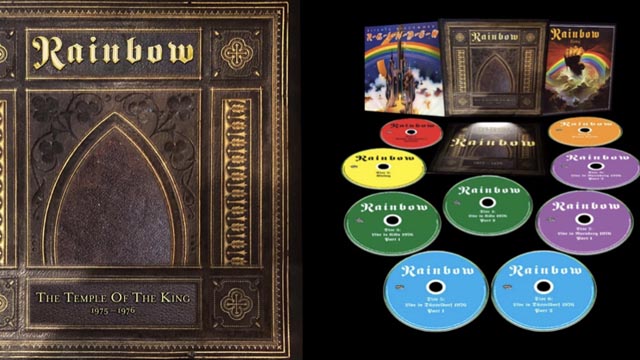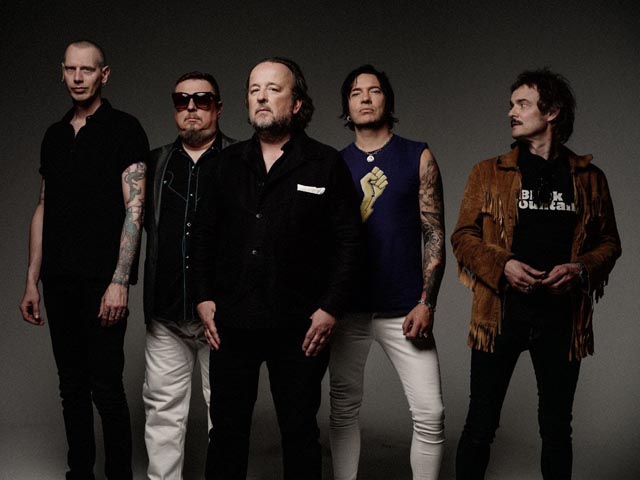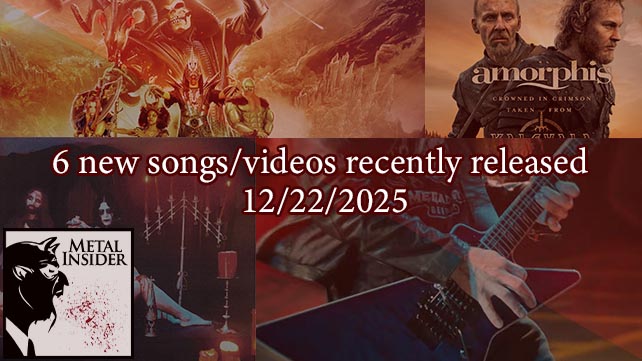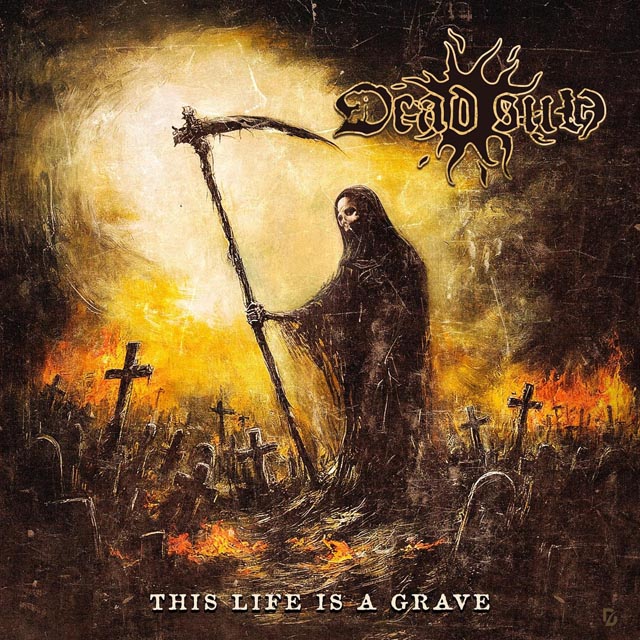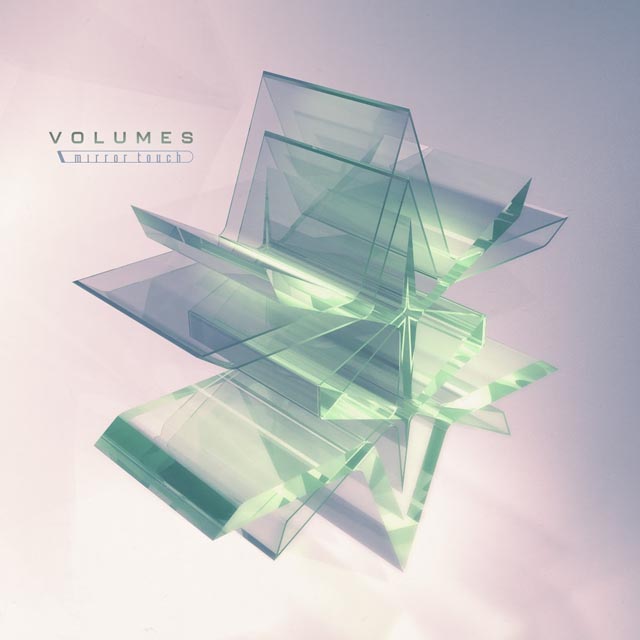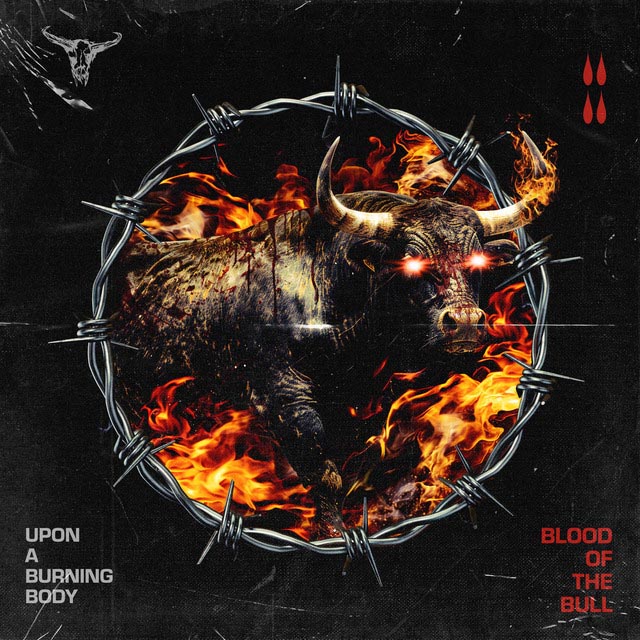Satanic Warmaster’s Werwolf is a legend whose mere name and towering reputation arouse the utmost reverence. His sublime creations leave all but his fellow superhumans in a state of fear and trembling, turning men into mere mice and exposing the inauthenticity of most modern metallers by mere comparison. Although Werwolf has participated in an absolutely dizzying number of projects, his best-known brainchild remains the beloved Satanic Warmaster, founded in 1998 in Lappeenranta, Finland. Werwolf is not only one of Scandinavia’s artistic leaders, but also one of the most important and iconic figures in black metal worldwide.
In 2023, Satanic Warmaster’s most recent triumph, the majestic Aamongandr, topped the Finnish charts for physical record sales in two separate categories, climbing above the likes of Uriah Heep without any help from the press. Verily, it descended like a seraphic weapon of mass destruction, executing its unforgettable surprise attack in December 2022 after year-end lists had been posted everywhere and many editors happened to lie beyond reach. Yet, in addition to only a couple of other insidious gems, Aamongandr clearly represents the crowning glory of the year and far beyond, the magical gift of which arrived in my inbox the day after Christmas in the curious form of a promo. This instant classic boasts a stunning cover by the now-late American artist Ken Kelly. In time, I hope that Kelly’s work for Satanic Warmaster’s sixth full-length scorcher will become as famous as his paintings for Kiss, Manowar, and Rainbow’s Rising.
Indeed, an enigmatic genius with a huge following, the regal Werwolf never ceases to astound listeners with miraculous consistency. During my time as a black metal columnist at MetalSucks, I learned the following immutable truth, irradiant as a blaze in the northern sky: Werwolf is truly one of the only luminaries in the movement whose masterpieces will prove immortal. Despite, or rather in part because of my elitist snobbery, I can’t properly convey just how blown away I am by Werwolf’s achievements both as a musician and a label owner. For more than a quarter century, Werewolf Records has championed artistic freedom, overpowering musical supremacy, and a thoroughly uncompromising attitude. In one way or another, the king of wolves has contributed creatively to several of the outfits on his label.
I have heard countless rumors about Graf Werwolf, including the warning that he’s a really excellent person. Therefore, I was delighted and honored to have the opportunity to finally sit down with the Graf himself and find out more firsthand. However, I must confess: I, a dauntless little minion of death’s emissaries, have never felt so intimidated in advance of a discussion as when I prepared to speak with the Satanic Tyrant’s countryman, “The Foreverlost” yet always flawless Ville Hermanni Valo. With due reason, I consider this to have been my most important interview ever! Enjoy!
This year, you released two outstanding songs under The True Werwolf banner. And there was a different vinyl with another track from you last year. Can we expect more material, perhaps in the form of a new album from you soon?
Those new songs were taken from splits, 7-inches. Currently, there are no plans for an album.
I love Dead Flesh Stigma’s debut, Necrocosmic Death Ritual. It’s a fantastic album! While it’s extremely brutal, the experimental impulses are so wild as well. And you provided some vocals. Could you please tell me about contributing to that?
v-KhaoZ, whose idea the project was, we work really closely all the time. So, when he came up with that, it was more than natural since he wanted session vocalists to have appearances on the album. I was one of them.
I was a bit confused — I couldn’t necessarily tell which of the guests were singing where. Which parts of the album did you contribute to?
I really cannot remember which songs. But on the album, it’s me; it’s Hellwind, who used to sing for Sargeist; and the main guy from Azaghal; and then the ex-vocalist on Azaghal also. I think those are all the vocalists on the album.
v-KhaoZ has been astoundingly productive. For example, his EP, Encircle the Spectral Dimension, and album, The Nighthold, last year with Vargrav were both phenomenal. It’s crazy that the one followed the other by just months. What would you like to say about being a part of Vargrav?
I mean, I already did vocals when we played the few live shows that we did with Vargrav. So, naturally, when v-KhaoZ wanted to expand the lineup for the album with a vocalist and a real drummer and somebody else playing guitar beside him, I was his first choice.
Grieve is unbelievable too. The record that you released last year with them, Wolves of the Northern Moon, was amazing. What should we know about your work with Grieve?
That’s one of the projects from v-khaoZ. Like I said before, we work really closely together and collaborate a lot. So, that was part of that dynamic.
You used to front Horna, and you took the stage with them this year at Steelfest, and Satanic Warmaster performed at Steelfest the two previous years. How has your experience at the mighty Steelfest been?
My experiences at Steelfest have always been really good. I’ve been performing there, if not every year, at least most of the years that it’s been public. It was a private festival in the beginning for a close circle of friends, and I didn’t know the people at that time. But as soon as it became an actual, real festival, I think I’ve been there most of the years.
It would be impossible to overstate the merits of Satanic Warmaster. Could you please take me through the creative process a bit for Satanic Warmaster’s most recent sensation, Aamongandr, both in terms of the music and the lyrics?
I’m always having difficulties in examining my own processes. Usually, it takes a long time, and it starts with the general idea of what I want to make. Usually, I have separate musical and separate lyrical ideas, and there’s no real set pattern that I work in. It depends completely on the situation and the time and everything. And with this new album, I wanted to have it sound more like an actual band was playing. It was still made in different sessions with only a few people present each time. It’s hard for me to tell what it looks like because I’m so occupied with the actual work.
How was it collaborating with the sadly deceased but extremely important Ken Kelly?
I’ve been a Manowar fan since, I don’t know, close to 30 years or something. It was natural for me, once I had the resources, to hire cover artists that weren’t necessarily doing it pro bono. He was one of the first people that I contacted. And to my surprise also, he agreed to do it. I’m really honored to have his hard work on my album, and I think it might have been the last album cover he ever made.
Wow! This is silly, but I’ll take this opportunity to mention another person with the surname Kelly and say that it was very smart of Kim Kelly to include Nachzehrer on her MetalSucks list of the best albums of 2010, despite the fact that, as you have pointed out, some of her words are totally beyond comprehension given the concrete facts, and, dare I perhaps insinuate, mean! So, what is your next step for Satanic Warmaster?
The current next steps are still a bit unknown to me also. Hopefully, I will come up with something soon. But I usually don’t plan ahead that much. I work on impulses.
Let’s talk about the fact that you topped the physical album sales charts in Finland!
Yes, number one two times, both with the CD version number one on the charts and with the vinyl version also maybe a few months later again.
You have a huge fanbase, and you have like 300k followers on Facebook with Satanic Warmaster alone. And that’s especially mind-blowing, considering that the media, who are often neglectful of true black metallic excellence, doesn’t really cover Satanic Warmaster. I think that proof of the ignorance about black metal is likewise revealed by the fact that they largely pass over a lot of the stuff by Terratur Possessions as well. For the sake of readers, I’ll note that they are another fan-favorite label with some of the best releases. And, fortunately, because Ole seems to have a high IQ and nearly impeccable taste in music, they seem to be an admirer of yours. So, is there anything you would like to say about being commercially successful, even though not all journalists have grasped the true meaning of black metal?
I always took it as kind of a blessing to be away from all the promotion racket and everything like that because, in the end, especially in this day and age when people can decide for themselves what they want to listen to, they don’t need to read reviews. They don’t need to see a journalist praise an album. They don’t need any of that to find something that they think is interesting and something that touches them in a way.
You founded Werewolf Records in 1998, though under a different name, and you’ve been releasing so many incredible offerings through the label. I was wondering if there’s anything you would like to disclose or explain about the different things you have going on right now.
I’ve been fairly busy with upcoming releases recently. For example, we finally got the layout and the master audio together for a compilation of the Behexen demos, which are some of the best that were ever made in Finland in the ’90s, especially the late ’90s. So, that’s going to be pretty good, and I think we finally got the Maniac Butcher picture disc box set with all the albums sent to the press. It’s a huge project, and it costs a fortune to make, but I think that’s happening too. And what else? There’s going to be a CD version of the Satanic Warmaster From the Carelian Battlegrounds LPs that were originally released by Heavy Metal Super Star from Japan. And because of the ever-present threat of bootlegs appearing, we decided to make like a preemptive strike on that, and it’s going to be out on CD hopefully this year. It was recorded live in the studio with no dubs, but it’s going to be surprising for those who haven’t heard it. It’s going to be pretty good. There’s a lot of things on Werewolf Records that I’ve been working on, but they always move really slowly. So, I can’t even remember what I’ve been working on.
How do you have time for both Werewolf Records and your creativity? Running a label obviously takes a ton of time and is really hard.
I never thought about it in a way like, “How would I have time for it?,” because that’s the thing I want to do, and that’s the only thing I do. It’s my life’s work, and it’s my passion, but it’s also my work.
You have a great webshop. And also, you’re a record collector. Do you have any recommendations for us today? I know you post a lot of them on Instagram.
I’m looking at my record shelf right now, so if I would have to recommend something, it would be pretty hard to pick just a few. I can take the pile of the albums that I listened to the most recently. Let’s see. Okay. Here’s the new Witchtrap album, Hungry as the Beast. It came from the press yesterday before anybody else got it. That was a good one. I always liked that band. This is one of my all-time favorites, Revenge by Kiss. Then we have Rotting Flesh, some old death metal stuff. Oh yeah, this one I bought from the flea market a few days back — Silver Mountain and their second album, Universe. It’s a really killer Swedish heavy metal album from 1985. Helloween, the first MLP. Fucking rules! And the Helloween compilation, The Best, The Rest, The Rare. I remember when I was maybe 13 or 14, I used to listen to this all the time. Then I have the soundtrack for the movie TerrorVision. It’s pretty goofy. Yeah, that’s what I’ve been listening to recently.
Speaking of goofy, a while ago, you posted a picture that I think some people would find controversial and, you know, get very angry about — you were wearing a Ninja Turtle outfit, and you were listening to Vanilla Ice. So, do you approve of Vanilla Ice?
I don’t disapprove of him. I mean, he has good tunes.
While we’re talking about music in a broader sense, do you have any comment on the Finnish black metal scene at the moment? Finland has a lot of especially brave artists.
I always get asked this question, but, for me, there’s not much to say. There’s a handful of people that I’ve been working with for years and years, but, overall, I don’t really consider myself part of a scene. It’s just that in Finland in general, because of the small population, everybody knows each other. And that’s one of the things that already brings people together. And on a smaller level, it applies to the black metal scene. So, that’s just how it is. Of course, nowadays, since Finnish black metal has become a thing, abroad, a lot of opportunists are getting drawn to the style of music just to enjoy the profits of it. There’s a lot of examples of people coming from totally different areas of music just to get their share of the attention.
One of Finland’s other greats is clearly Mikko Aspa, and you’ve collaborated with Clandestine Blaze and his label. What can you share about working with him?
We’ve been friends for over two decades. He’s originally from Imatra, which is like 30 kilometers from here. At the time when we both started to be more active doing releases and stuff like that, we were both starting up, and we’ve been working with each other ever since. It came really naturally.
Thinking about Aspa’s label makes me want to take things a few steps back: Is there anything you would be willing to share about the creative freedom that having your own record label allows you?
Yeah, that’s one of the reasons why I started Werewolf Records in the first place: to eventually have total control over my own creations and also to help artists that deserve to get attention but don’t necessarily have the resources themselves to go all the way.
Is starting a record label for a band that, say, wants to have total creative control something you would recommend? Again, it takes so much time.
I wouldn’t recommend it, but if I would have to do it all over again, I would do it this instant. When I started Werewolf Records as an official business in 2004, 20 years ago, for the first, at least, 10 years, I worked on it completely like hand to mouth, and it still took a lot of work afterward. But in the long run, it’s been the only way that I would ever make it.
What do you think has been the biggest challenge of operating your label?
My laziness.
But come on, that can’t be true because you’re ridiculously prolific. Obviously, you’re not lazy at all but the very opposite.
My impulses are extremely strong, but my work ethic, on the other hand, isn’t necessarily. But if the impulses are strong enough, then that can carry.
You’ve produced and recorded vocals for Archgoat. Please fill me in on your experience with them.
It was funny. Initially, when they made their first few comeback albums, I criticized their sound heavily because I was always a big fan of the Angelcunt mini-LP and the demo and everything. I was kind of bummed out because their new sound wasn’t as heavy as it could have been. So, yeah, I publicly criticized it a lot in many instances. So, it ended up that the Archgoat brothers approached me and asked me if I wanted to produce their recordings. And ever since the first one I produced with my sound engineer, Heavenly Vulva (Christ’s Last Rites), you can hear a clear difference.
What are the things that you keep in mind most when producing? And what might you say about getting the right balance between the rawness and the polish, the more beautiful aspects?
It always depends on the band and the artist completely. Usually, I can just feel how it should be. In Archgoat’s case, it was wanting to revive the certain sound that they had in the beginning, which was really specific to them. So, it depends totally on the case. But usually, if the band is going to be raw, and their expression is raw, then those qualities have to be conveyed in the sound also.
Do you have any favorite recording gear?
No. Well, I like my old cassette 4-tracker. That’s more like sentimental value.
How old is it?
It’s the one that I bought for the recordings of Carelian Satanist Madness. So, it’s actually one of the last ones they ever made — it’s made by Korg. It’s Korg’s CR-4. I think it was made in 2004 or 2005.
Does it still work, or, as you said, it’s just more about sentimental value?
Yeah, it still works. Now, I have two of those, but still, it works fine. And I’ve been using it up to this day.
Besides what we’ve discussed with Werewolf Records, are there any upcoming projects that you maybe want to tell us about? Any plans?
I don’t know if there’s anything that significant coming out. Of course, I have my desk drawers full of everything, but if there’s anything worth mentioning… Nothing comes to my mind, sorry.
You saw Beherit live this year, and you’ve worked with Holocausto for the Messe des morts reissues. What can you reveal about working with him?
The first time I got in touch with him was like in the mid to late ’90s, and we had some correspondence back then. And then, after Werewolf Records started going a bit better, I approached him initially to re-release the Goat Vulva material, which turned out spectacular. And then, after that, it went really well. We worked on the Messe des morts 7-inch reissue, and it turned out great as well. Beherit is possibly the most important black metal band for me, so it was naturally a big deal for me. And to see them live was something that, if you would have told me 20 years ago, “Oh, you’re going to see Beherit live in 20 years,” I don’t think I would have believed it because Beherit wasn’t really that active anymore. I wasn’t able to see them live when they were still active in the ’90s because I’m not old enough. So, it was great.
I don’t think they announced that show much in advance…? I didn’t hear about it until maybe the last minute, and that wasn’t from the press. I think they kept it a bit quiet?
There was gossip going on, and birds were chirping all around, but they didn’t announce it way ahead of time. I think they announced the show in Finland well after they announced the show in Japan.
It looks like Yosuke did a great job organizing the Japanese show.
Yeah, I was initially planning on going to Japan myself, but, luckily, I didn’t have to go. It would have been a lot of money and a lot of time. And we had a show ourselves the week after that concert in Japan, so it would have been a bit overkill.
How was Japan for you?
It was amazing when we played there in 2014, even though the black metal fanbase and everything… Even though there have been bands in Japan for ages, overall, the audience and the scene, it’s still fairly undeveloped. When Mayhem or Marduk tour in Japan, they play for audiences that are maybe 300 people. And for us, it was the same. And so, it’s more level there.
Are there any locations that you haven’t played in that you would maybe like to visit?
Yeah, I’d like to play more especially in Asian countries. I would like to play in China, and, if it would be possible, to play in, I don’t know, Thailand and places like that. That would be interesting. And also, Australia and countries like that, places that are a bit farther away.
Has continuing to spread your message to the States been at all difficult?
My message has been spread to the States pretty well, especially because of our cooperation with Hells Headbangers. So, I don’t think there’s a problem with that. Naturally, booking shows in the United States is difficult because of the visas and the flights and everything. It’s fairly expensive compared to the amount of audience you can get. For one city in the United States, you would have to have like a US tour, and we’re not really interested in doing actual tours. That’s not really for us.
What do you like most about playing live?
Initially, I do it as a gesture of my appreciation to the fans who make it possible for me to do what I do. But for me, it’s somewhat insignificant if I play live or not.
Since we touched upon the US, I’ll just add that USBM is gravely lacking. There are hardly any bands from the States whom I consider to be even remotely tolerable. In my opinion, the best American-born artist who’s still making black metal is Gabe Jorgenson. He founded a band called Parfaxitas that has an international lineup, which features Bjarni from Sinmara and K.R from Whoredom Rife. Parfaxitas is on Terratur, and they released a fabulous album this year called Weaver of the Black Moon. [And you can’t tell it isn’t 100% from Scandinavia.] But the point is: I don’t think that, for the most part, people understand black metal here.
Yeah, I’ve seen that, especially with the younger generation. They seem to have a big issue with the themes and the concepts and the mentality of black metal and how it collides with what they think are universal human values. So, there’s a conflict that causes them to have this kind of weird relationship with black metal. On the one hand, it’s music that they clearly enjoy, but, on the other hand, it’s made by people and made from philosophies and ideas that are, I don’t know, like an abomination for them.
That is proof that they are hypocrites. If they don’t value freedom and diversity of speech, thought, and religion, they stand against their own supposed ideals. That brings me to this: I don’t like the word “true,” but I really appreciate that you preserve the essential elements that black metal should have while still being a complete individual. You’ve worked with Mütiilation, and I was very happy about their return and new album because it was really dangerous and awesome. So, what are your thoughts right now on keeping black metal namely that, dangerous, in 2024 when the movement has been infiltrated by so many horrible posers and clone bands?
Yeah, well, naturally, in this day and age, people think that they’re gonna make a difference, that they’re gonna change black metal, and they’re gonna make it like more “acceptable” and “better.” We’ve seen people come and go around black metal for so many years that it’s safe to say that those who truly believe in those things that lie behind the music and everything… It’s gonna last. It doesn’t necessarily require any drastic moves to make it remain because those things that have been there since the ’80s and the ’90s, they’re still there. And those are the things that make it so vital now. And whatever things might happen in black metal now, it’s still gonna be just like a passing trend, and it doesn’t matter.
Agreed. Is there anyone that you would like to collaborate with that you haven’t yet?
I always get some ideas, and I occasionally ask people to collaborate. But at least currently, nothing has come to fruition in that sense. But it’s been known to happen.
I already asked you about your personal record collection and mentioned your webshop, but if you were going to select a few things from your shop for a new customer, what would your first picks be? [From the site, I urge everyone to buy, in addition to ALL available releases by Werewolf Records, the following: Nargaroth, Corneus, and Grausamkeit who have foreseen my demise in the midtro “Jill’s Death.”]
I always had the principle that I won’t sell stuff that I wouldn’t buy myself. So, in that sense, you can say that every album that I take in for distribution, I can recommend in one way or another.
One of my top picks in general would be Finland’s outstanding and totally horrifying Cold Prophet by Mr. Tuomas Tahvanainen, a brilliant visual artist as well. Have you heard Cold Prophet yet?
Yeah, I’ve heard it. It’s pretty good.
Have you heard their split, Imperiled Future?
That one, I don’t think I’ve heard.
It’s with K.F.R, Maxime Taccardi’s main band. And, obviously, he has beautifully rendered you in his blood.
***
Eternal hailstorms of thanks to Werwolf for his work and this interview. You can support his Satanic Art by visiting his site here. May his war continue to ignite ravenous black flames everywhere, obliterating the envoys of the false, weak, and subpar.
“Black metal is Will and Power.”

